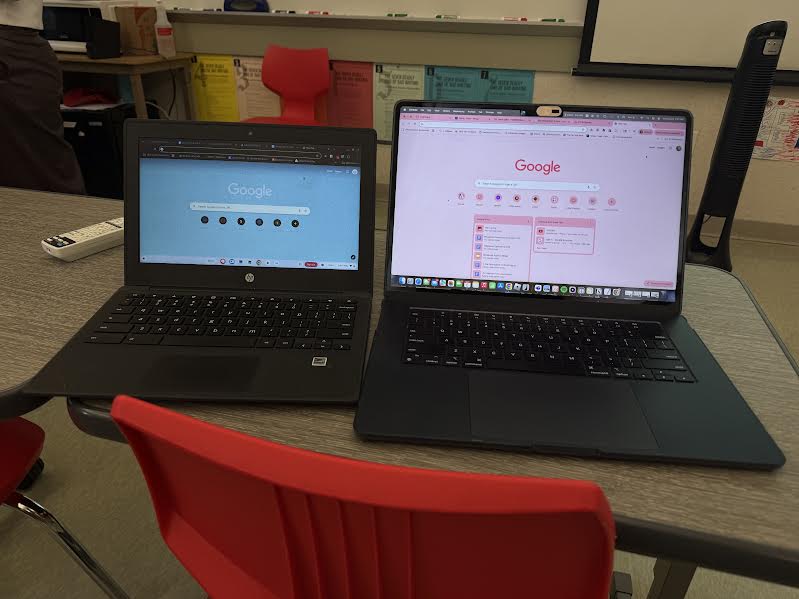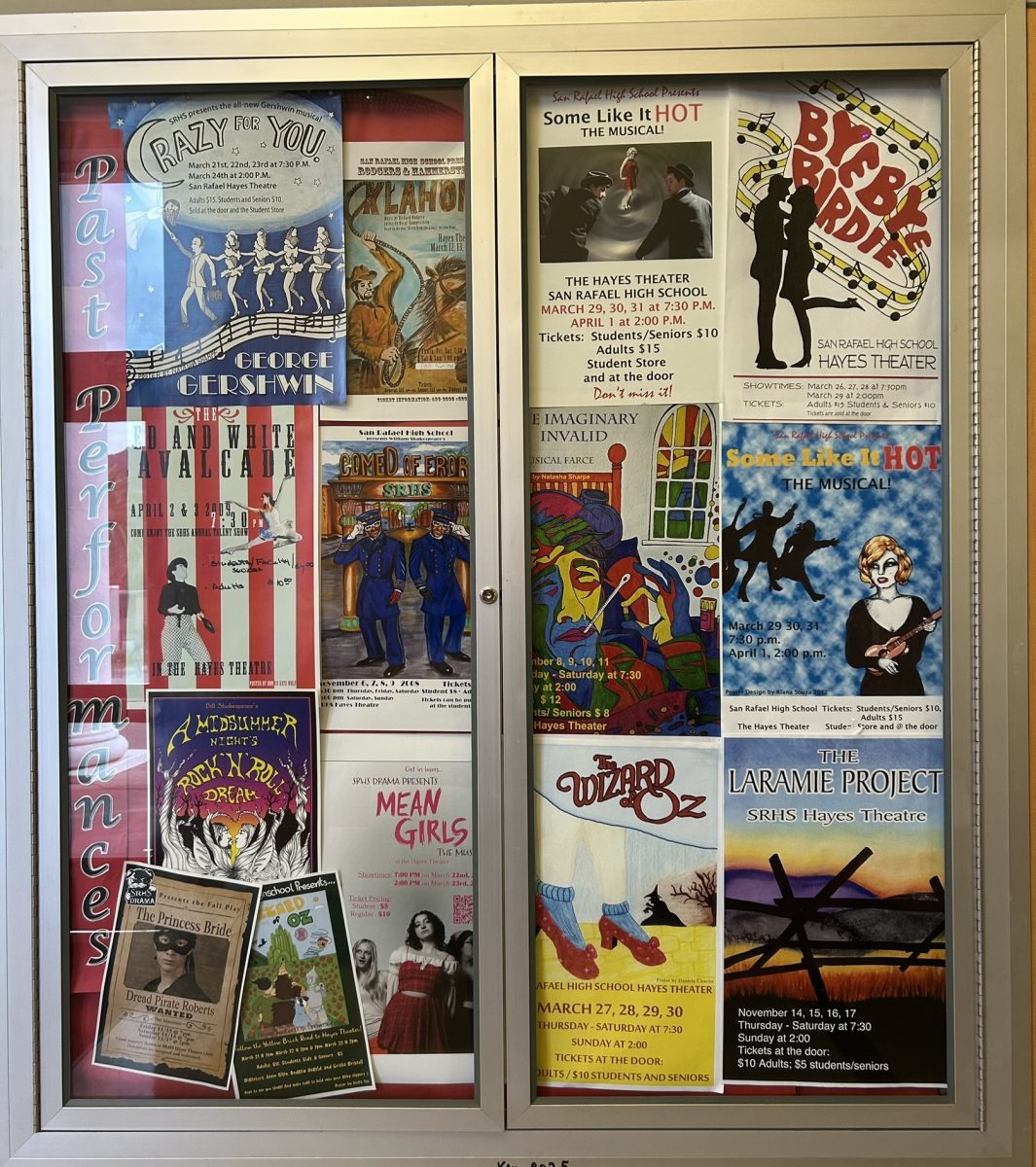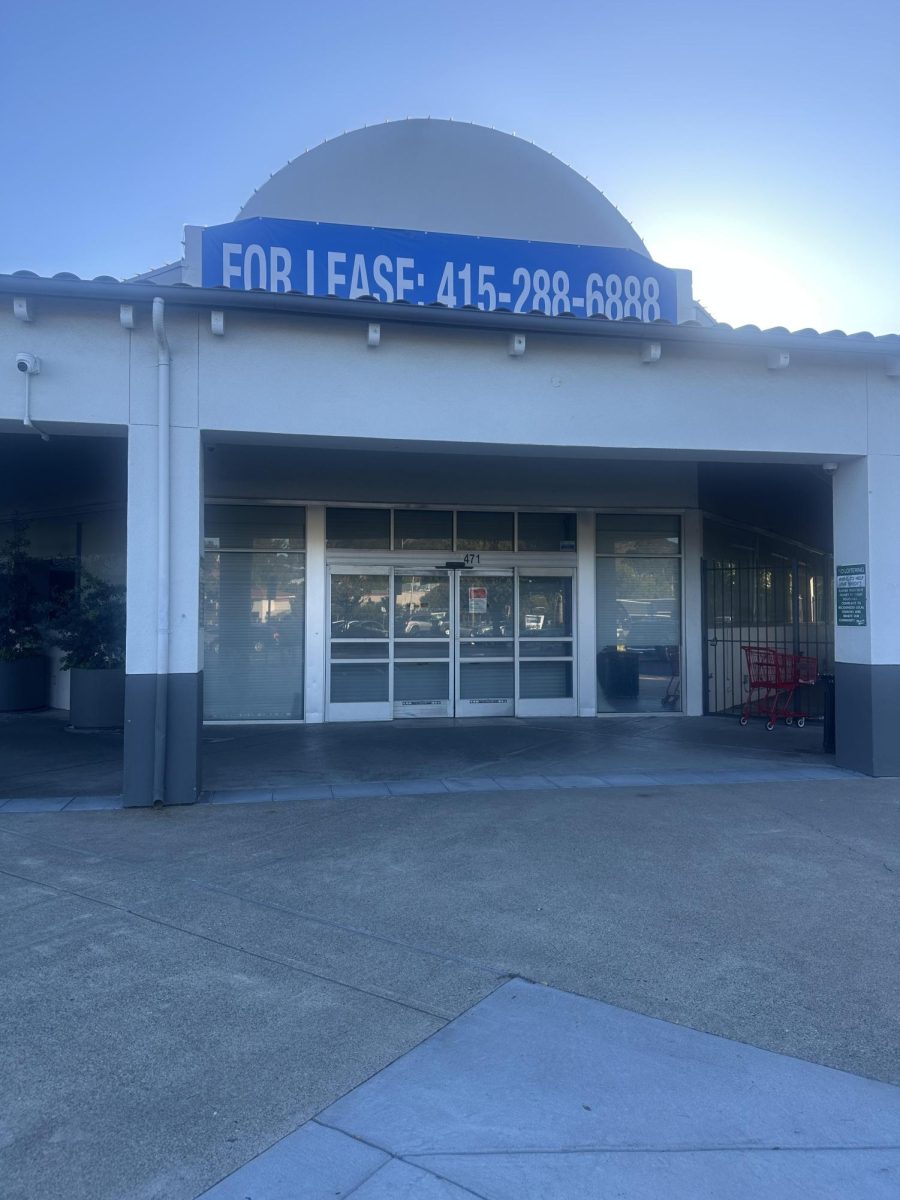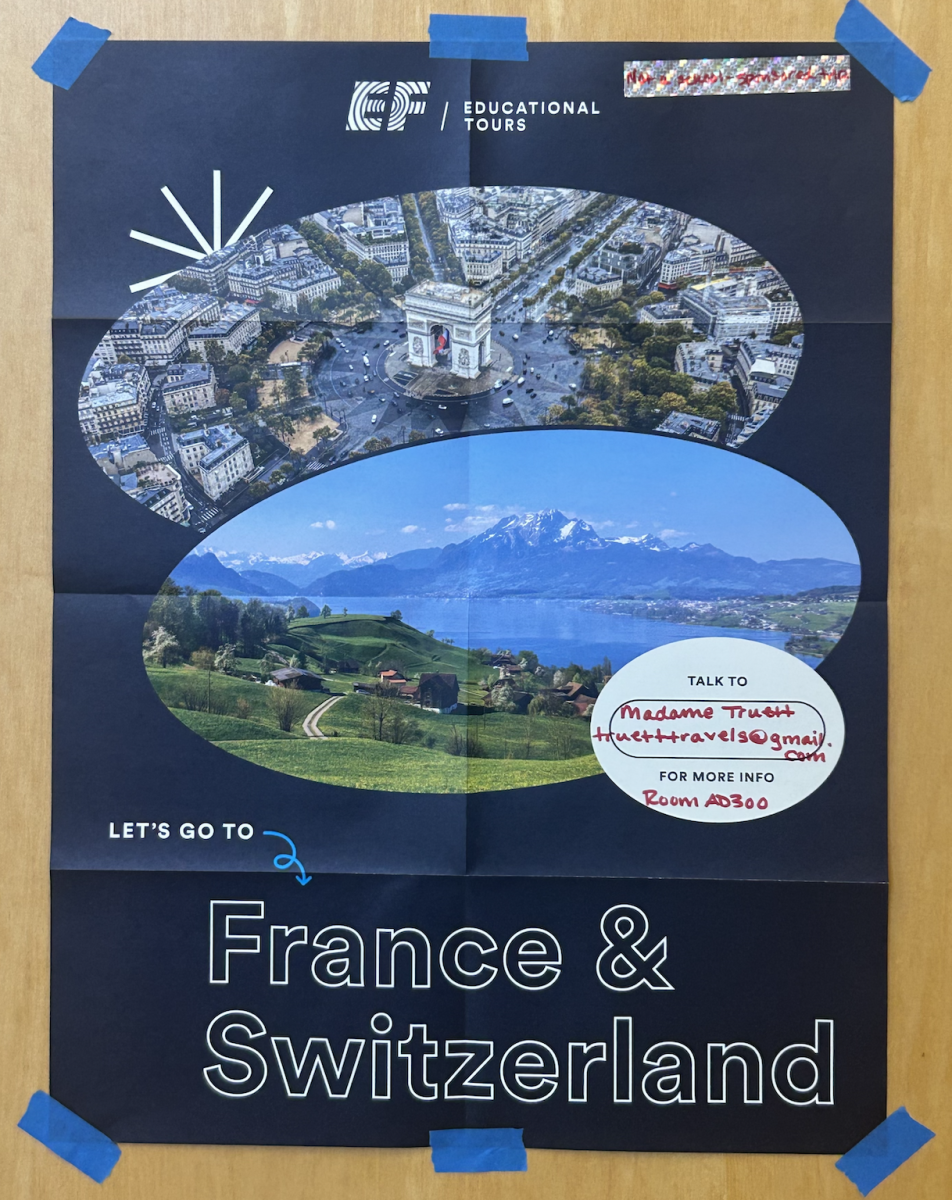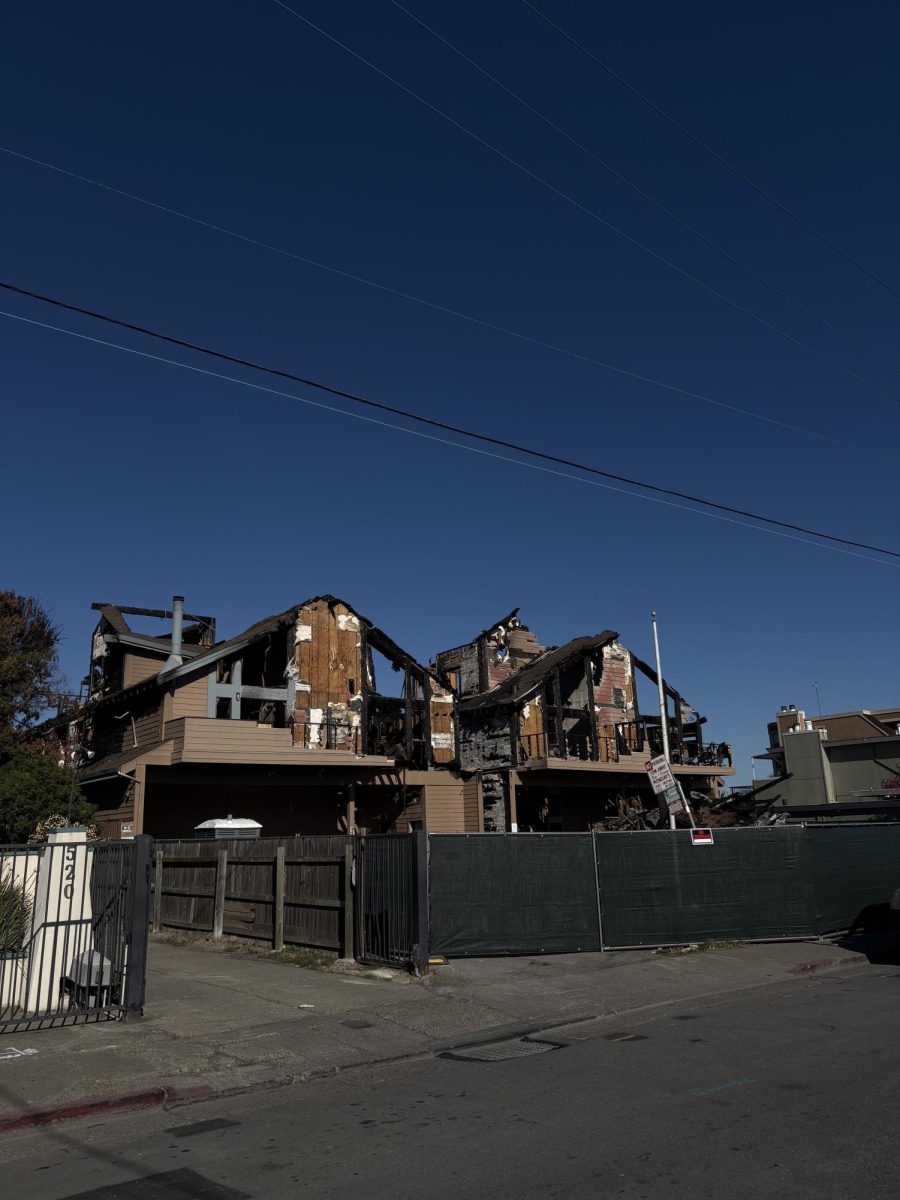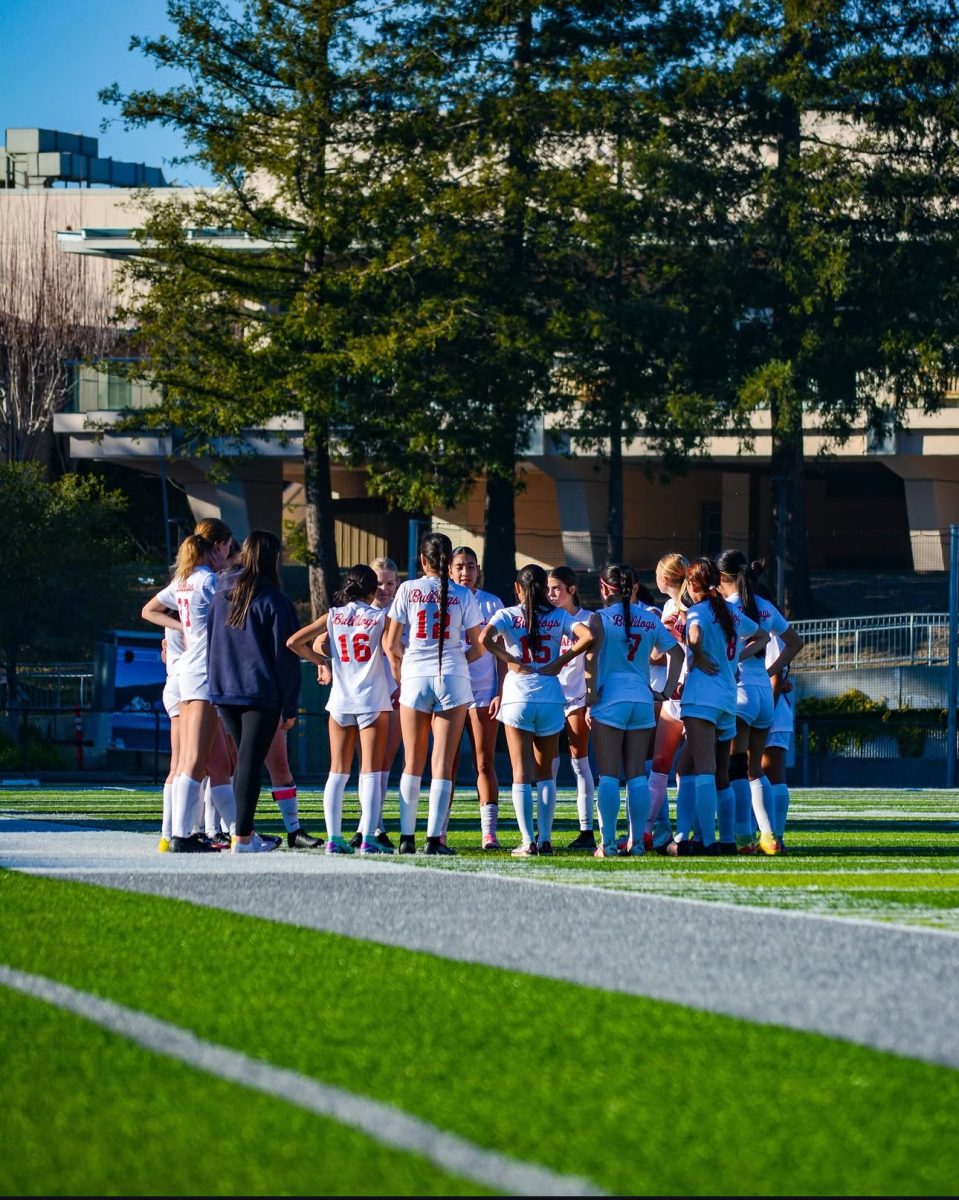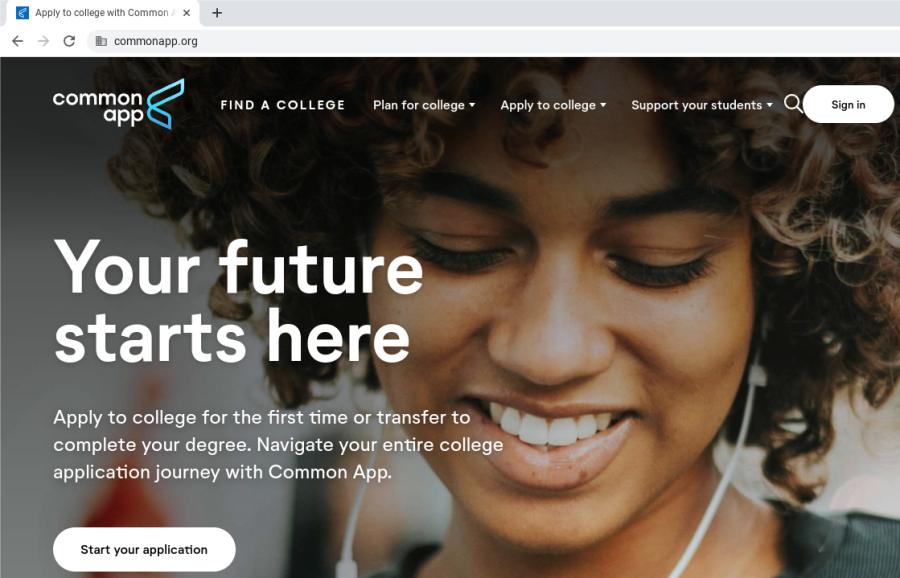How to Apply to College: Seniors Say Start Early (TRANSLATED INTO SPANISH)
February 8, 2023
Congratulations! We look forward to reviewing your application.
This message is familiar to the high school seniors who have spent the last semester applying to college. Submit buttons have been pressed, application deadlines have passed, and these seniors are relieved to be finished with their college apps. Some who applied early already received admissions decisions, and the rest have little to do but patiently wait.
College applications are different for every student, but some aspects generally remain consistent. I spoke with several SRHS seniors to hear about their reflections on the process and what advice they would give to students who plan on applying in the future. One thing that almost all of them recommended was to get started early.=
“My biggest piece of advice is to start early,” says senior Kendra Chung. “Just getting a headstart makes you feel so much less stressed.”
“I was told to start early like everyone else, but I didn’t really do it until last minute,” says senior Andre Culo. He delayed writing his essays because he wanted them to be perfect. However, he realized that “the best thing to do is just to start writing.”
Senior Sarah Mardesich says, “If I could go back in time I would definitely start it earlier.”
So what does it mean to start early? Seniors say the point is not to start stressing about college as a freshman. However, putting in a little work ahead of time can go a long way towards making the application process easier, whether it’s a year in advance or even just the summer before senior year.
An important step in preparing for college applications is to understand the options available to you. In California, students have access to a myriad of public universities through the California State University (CSU) and University of California (UC) systems. Students can also apply to out-of-state public schools, private colleges across the country, or even universities in other countries.
Depending on where a student applies, they will have to fill out different applications. While some schools have their own unique applications, many have streamlined the process. For example, both the CSU and UC systems use a single application that allows students to apply to any number of their schools. Similarly, hundreds of private schools employ a platform called Common App, which allows students to apply to many schools from one centralized application.
Each application is unique. While they all generally call for the same basic information, some have additional requirements such as supplemental essays, recommendation letters, or standardized test scores, although many institutions are moving away from this practice. This can create major differences in the time and effort needed to complete the application. Some can be completed in a matter of hours, others can take months of work.
Senior Maria Keane applied to five CSUs and just one UC. Because the CSU application does not require any essays, the only ones she had to write were UC’s Personal Insight Questions. She found the college application process to be much better than she was expecting.
“I was so scared of it and I shouldn’t have been,” says Keane. “The CSU application is so easy. If you have all the stuff you can fill it out in half an hour.”
Of course, the more schools a student applies to, the more complicated things become. Every application takes time to complete and costs money to submit. The average college application costs $50 to submit, with some ranging up to $100, although most schools have fee waivers for students who cannot afford to pay.
“You do not need to apply to a lot of different schools,” advises Chung. Rather than applying all over the map, she narrowed down her list to the schools she felt that she would really like to attend, mostly smaller private schools in Southern California. This allowed her to focus her efforts, making sure each application was completed to the best of her ability and finishing it all before winter break.
There are many factors that go into choosing schools, including size, location, majors, campus life, and cost. Some students tour different campuses to get a feel for what they prefer, taking advantage of spring break or summer vacation to travel to schools that are farther away. However, if touring is not accessible to a student, the internet provides a variety of other options. Whether it’s participating in virtual campus tours, watching student vlogs, or reading about a school on their website, there are many ways that students can learn more about college life.
For senior Stephanie Mendez, a first-generation college applicant, the application process was a challenge because she couldn’t go to her parents or older siblings for help. However, the internet ended up being a valuable resource that she could rely on.
“I’ve used YouTube, which is surprising to some people,” says Mendez. “I’ve found so many helpful tips on how to start writing my Common App essays, how I should be drafting my UC prompts, and what cliche and overused topics I shouldn’t be talking about.”
Taking the time to research college doesn’t just make the application process easier. It also allows students to explore their options and find the path that is best for them.
This was the case for senior Leslie Obiedo. Originally, she wanted to study veterinary science at her dream school, UC Davis. However, she started to wonder if a four year university was the right choice. When she realized she wasn’t feeling ready to leave home yet, her brother encouraged her to explore the option of community college.
“At first, I thought it was only for people who didn’t care about school, which made me fear that people would judge me,” says Obiedo. However, the more she learned, the more she realized it was a better fit for her. “The lower tuition and more flexible class schedule [will] allow me to continue my current paid internship while also continuing to learn how to do cosmetic services.”
The California Community Colleges system consists of 116 schools, each completely open to anyone resident with a high school diploma. Obiedo plans to attend College of Marin for a few years before transferring to a UC. She advises students to not let others’ opinions keep them from choosing the option that is best for them.
“Don’t feel pressure to go to a fancy, expensive, rigorous school if that’s really not what’s right for you,” agrees Keane. “Do a lot of research, figure out what you want to do with yourself.”
Beyond just research and understanding the process, there are other steps that students can take to get a headstart on their applications. Several seniors recommended that students get involved in and keep track of their extracurricular activities as early as freshman year, since many colleges ask for a list of your extracurricular activities throughout high school.
Senior Isabelle Nicandri advises students to not do extracurriculars just to look impressive to schools, but rather to do something that feels meaningful and fulfilling. For her, this was volunteering to make architecture drawings for the nonprofit Big Skills Tiny Homes.
“It just made everything less stressful,” says Nicandri, who wrote and spoke about this experience extensively throughout her application. “If you have something you’re passionate about, it just flows.”
“If you’re doing community service, it would be extremely valuable to log the hours you are doing,” explains senior Andreas Psychoyos. “[But] in a super low stress way, you don’t have to be super meticulous.” Psychoyos also encourages students who need recommendation letters to secure teachers to write them far in advance, and regularly check in with them about upcoming deadlines.
More importantly than these tips, every senior that I spoke to had someone who could support them. For some it was a parent or sibling who could help with applications. Other students hired a private college counselor to help them navigate the admissions process.
One such counselor is Laurie Cortez, founder of College Coaching Services. Cortez offers “a comprehensive package designed to individually assist students with their college application process.”
Cortez works with students of all grade levels. For those who start freshman or sophomore year, she focuses primarily on building their resumes and transcripts. She believes that “strong grades” and “strong resumes” are the key to a successful application, highlighting the importance of academic rigor and getting the basic requirements down solidly.
In terms of extracurriculars, Cortez encourages students to get involved in and show leadership in their areas of interest. “If your passion isn’t there, it won’t come through in your application,” she explains.
Most of Cortez’s clients begin meeting with her during their junior year. She helps students identify their goals and organize their schools into safety, probable, and stretch categories. Then she works with them on any aspects of application that they need help with.
“I believe the essays are the toughest part of the application,” says Cortes. She encourages her students to start as soon as possible and keep an essay journal where they can jot down any ideas they might have.
For services that Cortez does not help with personally, like SAT or ACT prep, she refers her clients to outside resources, like prep classes, tutors, or Khan Academy’s official (and free) SAT practice resource.
Of course, private college counselors are not cheap. Cortez’s fifteen session package costs a total of $3150. Meanwhile, other programs can cost upwards of $5,000 or $6,000. For many students, these expensive services are simply not an option. Luckily, there is a great resource that every SR student can access at zero cost: the College and Career Center or CCC.
“It’s really helpful especially because it’s through the school and it’s free,” says Mardesich. “They’re there for a reason and they’re awesome.”
The College and Career Center has a variety of resources available to students of all grade levels for every topic under the sun, including college applications, essay writing, financial aid, scholarships, resumes, volunteer opportunities, internships, and jobs. In addition to hosting many group workshops, the CCC also offers one-on-one meetings and check-ins to provide students with more personalized help, as well as College Nights to help educate parents and families.
Seydi Cifuentes Gudiel, SR’s resident College and Career Advisor, encourages students to visit the CCC and introduce themselves as soon as they can. “The better we know you as a student and your interests, the easier it is to connect you with opportunities,” she says.
However, Cifuentes Gudiel urges students not to stress themselves out with thinking about college before they are ready. “The drive to apply and go to college should come from the student, not external factors,” she says.
The CCC will start checking in with students during the second semester of their junior year, although students who are motivated can stop by to begin those conversations as soon as ninth grade.
“It’s okay to say I don’t know what to ask or do,” says Cifuentes Gudiel. “You don’t know what you don’t know. So just stop by the CCC and […] we will give you lots of information.”
Cifuentes Gudiel recommends that students who do have aspirations to apply to college understand the A-G requirements early on and ensure they are taking the right classes to be on track for the schools they want to attend. She also stresses the importance of community involvement and extracurricular activities, which is another thing that the CCC can help students navigate.
Even with these resources, applying to college can be overwhelming and exhausting. Throughout all the stress of the process, it is important that students remember to take things one step at a time and go at their own pace.
“Stay true to yourself,” encourages senior Piper Pomeroy.
Mardesich adds, “It’ll all be okay in the end.”
“We also want students to enjoy high school,” explains Cifuentes Gudiel. “This time goes fast and you’ll never have this experience again. College will happen for everyone that wants it to happen and there is no set timeline you have to follow.”
TRANSLATED BY THE AUTHOR:
Cómo Aplicar a la Universidad: Los Estudiantes de Último Año Dicen Comenzar Temprano
¡Felicidades! Nos alegramos de antemano a revisar su aplicación.
Este mensaje es familiar para los estudiantes de último año de secundaria que han pasado el último semestre aplicando a la universidad. Se presionaron los botones de envío, se vencieron los plazos de aplicación y estos estudiantes de último año se sienten aliviados de haber terminado con sus aplicaciones universitarias. Algunos de los que aplicaron temprano ya recibieron decisiones de admisión, y el resto tiene poco que hacer más que esperar pacientemente.
Las aplicaciones universitarias son diferentes para cada estudiante, pero algunos aspectos generalmente se mantienen constantes. Hablé con varios estudiantes del último año de SRHS para escuchar sus reflexiones sobre el proceso y qué consejos les darían a los estudiantes que planean aplicarse en el futuro. Una cosa que casi todos recomendaron fue comenzar temprano.
“Mi mayor consejo es comenzar temprano,” dice Kendra Chung, estudiante de último año. “Simplemente tener una ventaja inicial te hace sentir mucho menos estresado.”
“Me dijeron que comenzara temprano como todos los demás, pero realmente no lo hice hasta el último minuto,” dice Andre Culo, estudiante de último año. Retrasó la escritura de sus ensayos porque quería que fueran perfectos. Sin embargo, se dio cuenta de que “lo mejor que se puede hacer es comenzar a escribir.”
La estudiante de último año Sarah Mardesich dice, “Si pudiera retroceder en el tiempo, definitivamente lo comenzaría antes.”
Entonces, ¿qué significa comenzar temprano? Los estudiantes de último año dicen que el punto no es comenzar a estresarse por la universidad como estudiante de primer año. Sin embargo, hacer un poco de trabajo con anticipación puede contribuir en gran medida a facilitar el proceso de aplicación, ya sea con un año de anticipación o incluso solo el verano anterior al último año.
Un paso importante en la preparación para las aplicaciones universitarias es comprender las opciones disponibles para usted. En California, los estudiantes tienen acceso a una miríada de universidades públicas a través de los sistemas de la Universidad Estatal de California (CSU) y la Universidad de California (UC). Los estudiantes también pueden aplicarse a escuelas públicas fuera del estado, universidades privadas en todo el país, o incluso universidades en otros países.
Dependiendo de dónde se aplica un estudiante, tendrá que completar diferentes aplicaciones. Si bien algunas escuelas tienen sus propias aplicaciones únicas, muchas han simplificado el proceso. Por ejemplo, ambos el sistema CSU y el UC utilizan una sola aplicación que permite a los estudiantes aplicarse a cualquier número de sus escuelas. De manera similar, cientos de escuelas privadas emplean una plataforma llamada Common App, que permite a los estudiantes aplicarse a muchas escuelas desde una aplicación centralizada.
Cada aplicación es única. Si bien todos generalmente requieren la misma información básica, algunos tienen requisitos adicionales, como ensayos complementarios, cartas de recomendación, o puntajes de exámenes estandarizados, aunque muchas instituciones se están alejando de esta práctica. Esto puede crear grandes diferencias en el tiempo y el esfuerzo necesarios para completar la aplicación. Algunos se pueden completar en cuestión de horas, otros pueden llevar meses de trabajo.
Maria Keane, estudiante de último año, aplicó a cinco CSU y solo una UC. Debido a que la aplicación de CSU no requiere ningún ensayo, los únicos que tuvo que escribir fueron las Preguntas de Conocimiento Personal de UC. Encontró que el proceso de aplicación a la universidad fue mucho mejor de lo que esperaba.
“Estaba tan asustada y no debería haberlo estado,” dice Keane. “La aplicación de CSU es muy fácil. Si tienes todo el material, puedes llenarlo en media hora.”
Por supuesto, cuantas más escuelas aplique un estudiante, más complicadas se vuelven las cosas. Cada aplicación toma tiempo para completarse y cuesta dinero enviarla. La aplicación universitaria promedio cuesta $50 para enviar, y algunas cuestan hasta $100, aunque la mayoría de las escuelas tienen exenciones de tarifas para los estudiantes que no pueden pagar.
“No es necesario aplicarse a muchas escuelas diferentes,” aconseja Chung. En lugar de aplicarse en todo el mapa, redujo su lista a las escuelas a las que sintió que realmente le gustaría asistir, en su mayoría escuelas privadas más pequeñas en el sur de California. Esto le permitió concentrar sus esfuerzos, asegurándose de que cada aplicación se completara lo mejor que pudiera y terminarla antes de las vacaciones de invierno.
Hay muchos factores que intervienen en la elección de las escuelas, incluidos el tamaño, la ubicación, las especializaciones, la duración del campus y el costo. Algunos estudiantes recorren diferentes campus para tener una idea de lo que prefieren, aprovechando las vacaciones de primavera o de verano para viajar a escuelas que están más lejos. Sin embargo, si un estudiante no tiene acceso a las giras, la internet ofrece una variedad de otras opciones. Ya sea participando en recorridos virtuales del campus, viendo blogs de estudiantes o leyendo sobre una escuela en su sitio web, hay muchas maneras en que los estudiantes pueden aprender más sobre la vida universitaria.
Para Stephanie Méndez, una estudiante de último año y una solicitante que será la primera generación de su familia en ir a la universidad, el proceso de applicación fue un desafío porque no podía acudir a sus padres o hermanos mayores en busca de ayuda. Sin embargo, la internet terminó siendo un recurso valioso en el que podía confiar.
“He usado YouTube, lo cual es sorprendente para algunas personas,” dice Méndez. “He encontrado tantos consejos útiles sobre cómo comenzar a escribir mis ensayos de aplicación común, cómo debo redactar mis indicaciones de UC y sobre qué clichés y temas usados en exceso no debería hablar.”
Tomarse el tiempo para investigar la universidad no solo facilita el proceso de applicación. También permite a los estudiantes explorar sus opciones y encontrar el mejor camino para ellos.
Este fue el caso de la estudiante de último año Leslie Obiedo. Originalmente, quería estudiar veterinaria en la escuela de sus sueños, UC Davis. Sin embargo, comenzó a preguntarse si una universidad de cuatro años era la elección correcta. Cuando se dio cuenta de que aún no se sentía lista para irse de casa, su hermano la animó a explorar la opción de la universidad comunitaria (community college).
“Al principio pensé que era solo para personas a las que no les importaba la escuela, lo que me hizo temer que la gente me juzgara,” dice Obiedo. Sin embargo, cuanto más aprendía, más se daba cuenta de que encajaba mejor con ella. “La matrícula más baja y el horario de clases más flexible me permitirán continuar con mi pasantía remunerada actual mientras continúo aprendiendo cómo hacer servicios cosméticos.”
El sistema de Colegios Comunitarios de California consta de 116 escuelas, cada una completamente abierta a cualquier residente con un diploma de escuela secundaria. Obiedo planea asistir a College of Marin durante algunos años antes de transferirse a una UC. Ella aconseja a los estudiantes que no dejen que las opiniones de los demás les impidan elegir la mejor opción para ellos.
“No sientas la presión de ir a una escuela elegante, costosa y rigurosa si eso no es realmente lo que te conviene,” coincide Keane. “Investiga mucho, averigua qué quieres hacer contigo mismo.”
Más allá de solo investigar y comprender el proceso, hay otros pasos que los estudiantes pueden tomar para obtener una ventaja inicial en sus aplicaciones. Varios estudiantes del último año recomendaron que los estudiantes participen y realicen un seguimiento de sus actividades extracurriculares desde el primer año, ya que muchas universidades solicitan una lista de sus actividades extracurriculares durante la escuela secundaria.
Isabelle Nicandri, estudiante de último año, aconseja a los estudiantes que no hagan actividades extracurriculares solo para verse impresionantes en las escuelas, sino que hagan algo que se sienta significativo y satisfactorio. Para ella, esto fue lo que la motivó a ofrecerse como voluntaria para hacer dibujos de arquitectura para la organización sin fines de lucro Big Skills Tiny Homes.
“Simplemente hizo que todo fuera menos estresante,” dice Nicandri, quien escribió y habló extensamente sobre esta experiencia a lo largo de su applicación. “Si tienes algo que te apasiona, simplemente fluye.”
“Si está haciendo servicio comunitario, sería extremadamente valioso registrar las horas que está haciendo,” explica el estudiante de último año Andreas Psychoyos. “[Pero] de una manera súper baja en estrés, no tienes que ser súper meticuloso.” Psychoyos también alienta a los estudiantes que necesitan cartas de recomendación para asegurarse de que los maestros les escriban con mucha anticipación y les informen regularmente sobre los próximos plazos.
Más importante que estos consejos, todos los estudiantes de último año con los que hablé tenían a alguien que podía apoyarlos. Para algunos, era un padre o un hermano quien podía ayudar con las applicaciones. Otros estudiantes contrataron a un consejero universitario privado para ayudarlos a navegar el proceso de admisión.
Una de esas consejeras es Laurie Cortez, fundadora de College Coaching Services. Cortez ofrece “un paquete integral diseñado para ayudar individualmente a los estudiantes con su proceso de applicación a la universidad.”
Cortez trabaja con estudiantes de todos los grados. Para aquellos que comienzan el primer o segundo año, ella se enfoca principalmente en crear sus currículos y transcripciones. Ella cree que las “calificaciones sólidas” y los “currículums sólidos” son la clave para una applicación exitosa, lo que destaca la importancia del rigor académico y el cumplimiento sólido de los requisitos básicos.
En términos de actividades extracurriculares, Cortez alienta a los estudiantes a involucrarse y mostrar liderazgo en sus áreas de interés. “Si tu pasión no está ahí, no aparecerá en tu applicación,” explica.
La mayoría de los clientes de Cortez comienzan a reunirse con ella durante su tercer año. Ella ayuda a los estudiantes a identificar sus metas y organizar sus escuelas en categorías de seguridad, probabilidad, y extensión. Luego, trabaja con ellos en cualquier aspecto de la aplicación con el que necesiten ayuda.
“Creo que los ensayos son la parte más difícil de la applicación,” dice Cortez. Alienta a sus estudiantes a comenzar lo antes posible y a llevar un diario de ensayos donde puedan anotar cualquier idea que puedan tener.
Para los servicios con los que Cortez no ayuda personalmente, como la preparación para el SAT o el ACT, remite a sus clientes a recursos externos, como clases de preparación, tutores o el recurso de práctica para el SAT oficial (y gratuito) de Khan Academy.
Por supuesto, los consejeros universitarios privados no son baratos. El paquete de quince sesiones de Cortez cuesta un total de $3150. Mientras tanto, otros programas pueden costar más de $5,000 o $6,000. Para muchos estudiantes, estos costosos servicios simplemente no son una opción. Afortunadamente, hay un gran recurso al que todos los estudiantes de SR pueden acceder sin costo alguno: el Centro de Universidad y Carrera o CCC.
“Es realmente útil, especialmente porque es a través de la escuela y es gratis,” dice Mardesich. “Están ahí por una razón y son increíbles.”
El Centro Universitario y Profesional tiene una variedad de recursos disponibles para estudiantes de todos los niveles de grado para cada tema bajo el sol, incluidas applicaciones universitarias, redacción de ensayos, ayuda financiera, becas, currículums, oportunidades de voluntariado, pasantías y trabajos. Además de organizar muchos talleres grupales, el CCC también ofrece reuniones individuales y registros para brindar a los estudiantes una ayuda más personalizada, así como Noches Universitarias para ayudar a educar a los padres y las familias.
Seydi Cifuentes Gudiel, asesora universitaria y profesional residente de SR, anima a los estudiantes a visitar el CCC y presentarse lo antes posible. “Cuanto mejor te conozcamos como estudiante y tus intereses, más fácil será conectarte con oportunidades,” dice ella.
Sin embargo, Cifuentes Gudiel insta a los estudiantes a no estresarse pensando en la universidad antes de estar listos. “El impulso para aplicarse e ir a la universidad debe provenir del estudiante, no de factores externos,” dice ella.
El CCC comenzará a comunicarse con los estudiantes durante el segundo semestre de su penúltimo año, aunque los estudiantes que estén motivados pueden pasar para comenzar esas conversaciones desde el noveno grado.
“Está bien decir que no sé qué preguntar o qué hacer,” dice Cifuentes Gudiel. “No sabes lo que no sabes. Así que pase por el CCC y […] le daremos mucha información.”
Cifuentes Gudiel recomienda que los estudiantes que tienen aspiraciones de aplicarse a la universidad comprendan los requisitos A-G desde el principio y se aseguren de estar tomando las clases correctas para estar encaminados en las escuelas a las que quieren asistir. También enfatiza la importancia de la participación de la comunidad y las actividades extracurriculares, que es otra cosa que el CCC puede ayudar a los estudiantes a navegar.
Incluso con estos recursos, aplicar a la universidad puede ser abrumador y agotador. A lo largo de todo el estrés del proceso, es importante que los estudiantes recuerden tomar las cosas paso a paso e ir a su propio ritmo.
“Manténgase fiel a usted mismo,” alienta a Piper Pomeroy, estudiante de último año.
Mardesich agrega, “Todo estará bien al final.”
“También queremos que los alumnos disfruten de la escuela secundaria,” explica Cifuentes Gudiel. “Este tiempo pasa rápido y nunca volverás a tener esta experiencia. La universidad sucederá para todos los que quieran que suceda y no hay un cronograma establecido que deba seguir.”

